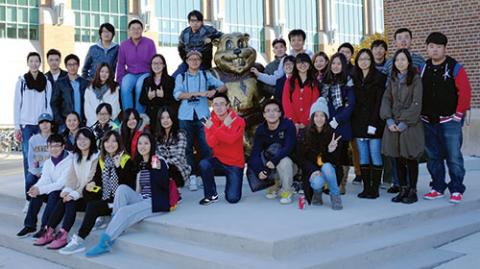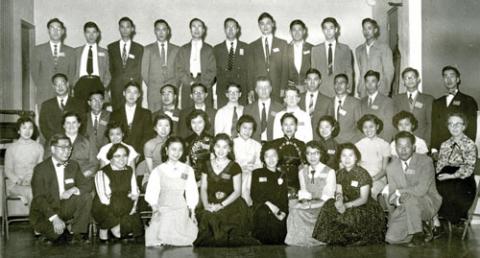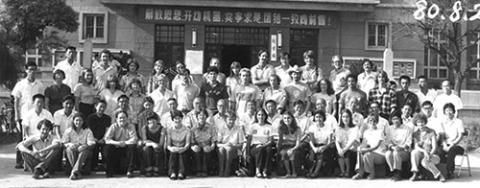The University of Minnesota is proud of its long-standing exchange of students with China. Thousands of Chinese students have chosen UMN for their academic career, and the University of Minnesota was one of the first U.S. universities to reopen academic ties and study abroad with China in the 1980s.
Chinese Students
The University of Minnesota has been an international institution since its earliest days, educating children of immigrants and offering foreign languages. Since as early as 1874, the University has welcomed outstanding international researchers and students to campus while sharing the best of Minnesota with the world. International students bring their unique backgrounds and viewpoints to university classroom, curriculum, and campus life, providing all students the opportunity to explore global perspectives.
The First Chinese Students

The first three students from China—Pan Wen Ping, Pan Wen Huen, and Kwong Yih Kum—enrolled at the University of Minnesota in 1914. They attended the St. John’s University in Shanghai and Tsinghua College in Beijing in China. Pan Wen Huen earned a bachelor of science degrees in chemistry in 1918 and metallurgical engineering in 1919. He settled in northern Minnesota after graduating and worked for a mining company for 40 years, retiring in 1959. Kwong graduated in 1918 with a bachelor of science in mining and returned to China.
These three students led the way for many more Chinese students to pursue their education and training at the University, specifically in science and engineering. Cha Chien, who was the first Chinese student to earn a doctoral degree from the University in 1923, became the founding president of Central China Institute of Technology (now Central China University of Science and Technology) in 1955.
In 1945, the University worked with the Food and Agricultural Organization of the United Nations to welcome 10 Chinese students to the University to study agricultural engineering. After graduation, the cohort returned to their homeland and became the first generation of agricultural engineering scientists in the People’s Republic of China. Notable alumni of this program include Dr. Zeng Dechao, academician at the Chinese Academy of Sciences, who co-founded the Beijing Agricultural Engineering Institute, and Dr. Tao Dinglai, academician at the Chinese Academy of Engineering, who became the Vice President of the Chinese Academy of Agricultural Sciences.
Student Organizations Build Community
The first three Chinese students, along with others, established the Chinese Students’ Club in 1915. By then, the University was home to more students from China and the club was able to recruit 14 members to join. The student organization was for Chinese students or those interested in topics related to China.


Study Abroad
The University of Minnesota was one of the first U.S. universities to take students to China in the 1980s. The past decades have seen sustained growth in U.S. international education, and more University students are choosing to study abroad in China to absorb new knowledge and skills, enhance intercultural competency, and broaden their international perspective. Today the University has more than 15 study abroad programs in China, including short-term seminars and semester exchanges.
The First Programs to China

In 1980, University of Minnesota students had their first opportunity to study in China through the “Summer Intensive Chinese Language Institute” held at Nankai University. Students from the University joined some 30 other students from various U.S. universities.
Ralph Rapson, head of the School of Architecture, sent the first group of architecture students to Tianjin University in Tianjin, China, in 1981. Since then, the architecture program has sent many more students to study abroad in China.

From 1984 to 1988, University of Minnesota Duluth Professors Cheng-Khee Chee and Terry Anderson led annual study abroad programs to Zhejiang Academy of Fine Arts. The program was called “Chinese Landscape Painting and Watercolor Painting” and had an average enrollment of 25 students each year.
A Variety of Options

Today, University students have a wide variety of programs to choose from that allow them to study, work, or volunteer in the greater China area. The 2013 study abroad program “Cutting-Edge Circuits and Systems in China” gave students the opportunity to explore current research and development activities in electrical and computer engineering in China.
The University of Minnesota Duluth’s Labovitz School of Business and Economics course “Business and Economy in China” in 2013 took students to China to tour various companies and learn about doing business in China.
Another business course offered in 2013 was “An Introduction to Global Entrepreneurship” through the Carlson School of Management. Students studied the conceptual and empirical knowledge about entrepreneurship at the individual, organizational, and industrial levels in China.
While the Humphrey School of Public Affairs has a long history with China, it kicked off its first study abroad program to China in 2013. The program provides University students the opportunity to meet with government, academic, and non-governmental organizations to learn about policy and planning challenges and innovations, and economic and environmental aspects of urban development.
This information was compiled in 2014 for China 100, a yearlong celebration honoring the first students from China and the wealth of connections that have come since.
